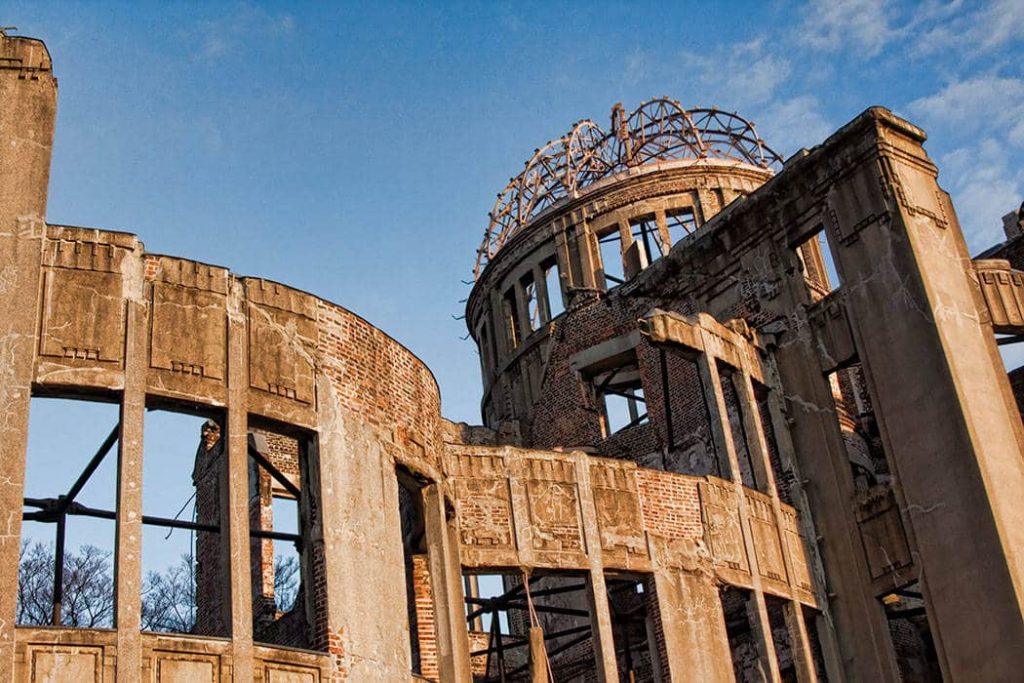
The Hiroshima Peace Park (known as Heiwakinen in Japanese) is the first place most visitors to the city aim for when they arrive. Whether you're making an intercity day trip or intend to base yourself in Hiroshima for a few days you're unlikely to come to town and not visit this site which serves as a prayer for peace, a memorial to the lives lost in the atomic bomb attack on the city during WWII, an important piece of Japans history and a gathering place for the local community.
The Peace Park is a 2.8-kilometre walk from the train station. You can follow the scenic route from our self-guided walking tour of Hiroshima, or take a local tram from outside the train station to the Genbaku Dome Mae stop opposite the Atomic Bomb Dome.
Jump to:
Atomic Bomb Dome
When the atomic bomb detonated on 6 August 1945 it was directly above the Hiroshima Commercial Exhibition Centre, the building now known as the Atomic Bomb Dome.
While the surrounding blocks were wiped out the building directly underneath was mysteriously left partially standing as the explosion radiated up and outwards.
The annual remembrance of the 140,000 people killed by the blast centres around the dome at the epicentre.

Peace Clock Tower
Cross the bridge from the dome and walk into the Peace Park itself. The clock tower was added to the park in 1967 by the Hiroshima Lions Club. At 8.15 each morning the clock chimes as a reminder for the need to be persistent in our efforts to push the world's governments for the safe destruction of all nuclear weapons.
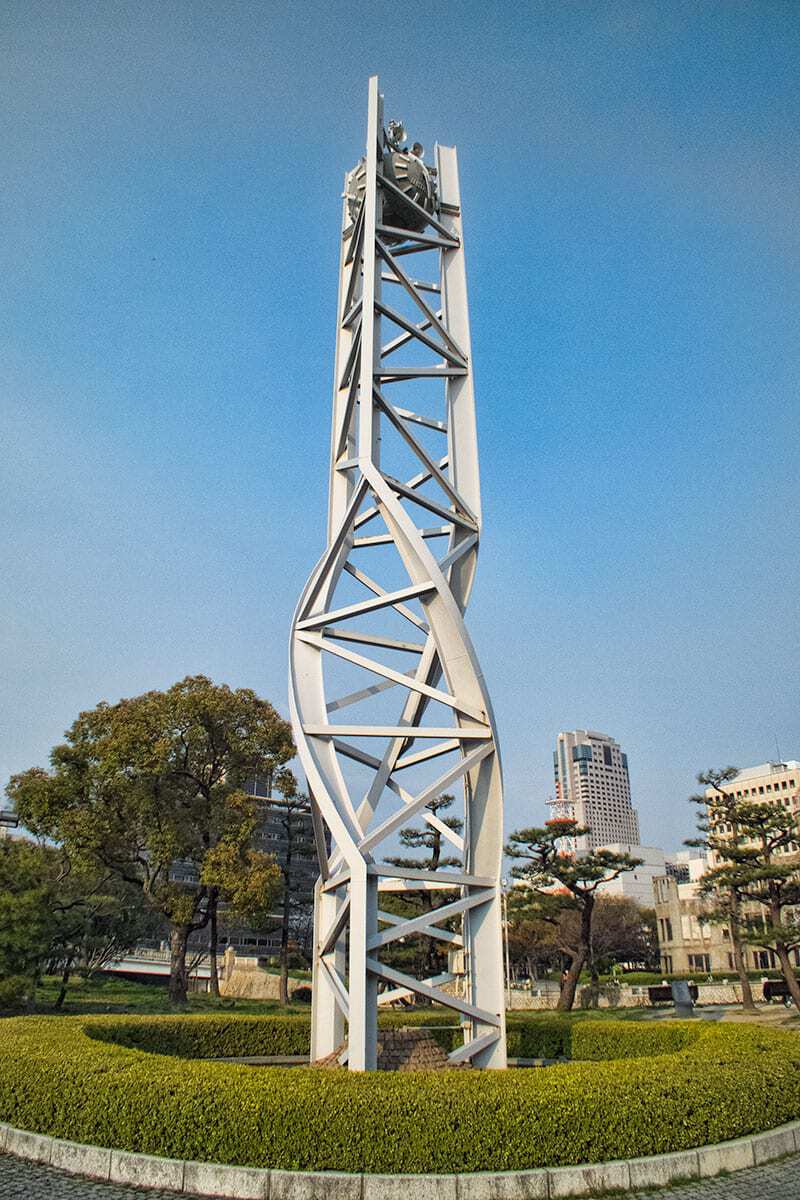
Peace Bell
Continuing south you'll come to the Peace Bell. The temple-style bell is symbolic of the spiritual and cultural movement for a truly peaceful co-existence without any nuclear weapons or wars. You may hear the bell toll as you're walking around. Visitors are invited to ring the bell as part of their own prayer for peace. The brass bell weighs more than a tonne and is set under an unusual dome structure representing the universe.
On a stone next to the bell it reads
Mourning the lives lost in the atomic bombing we pledge to convey the truth of this tragedy through Japan and the world, pass it on to the future, learn the lessons of history, and build a peaceful world free from nuclear weapons.
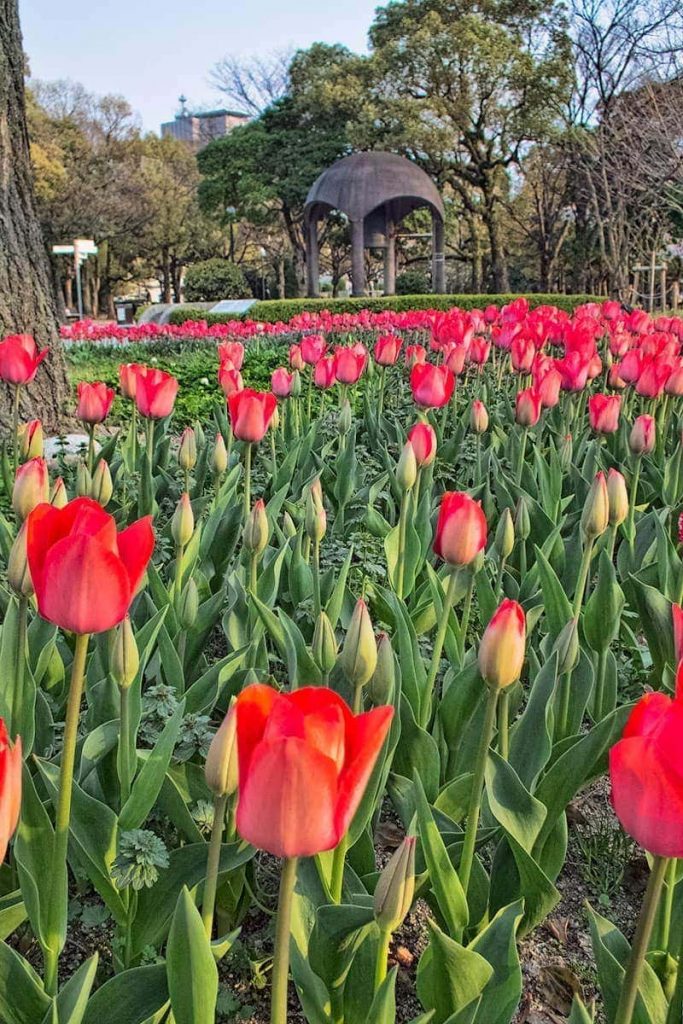
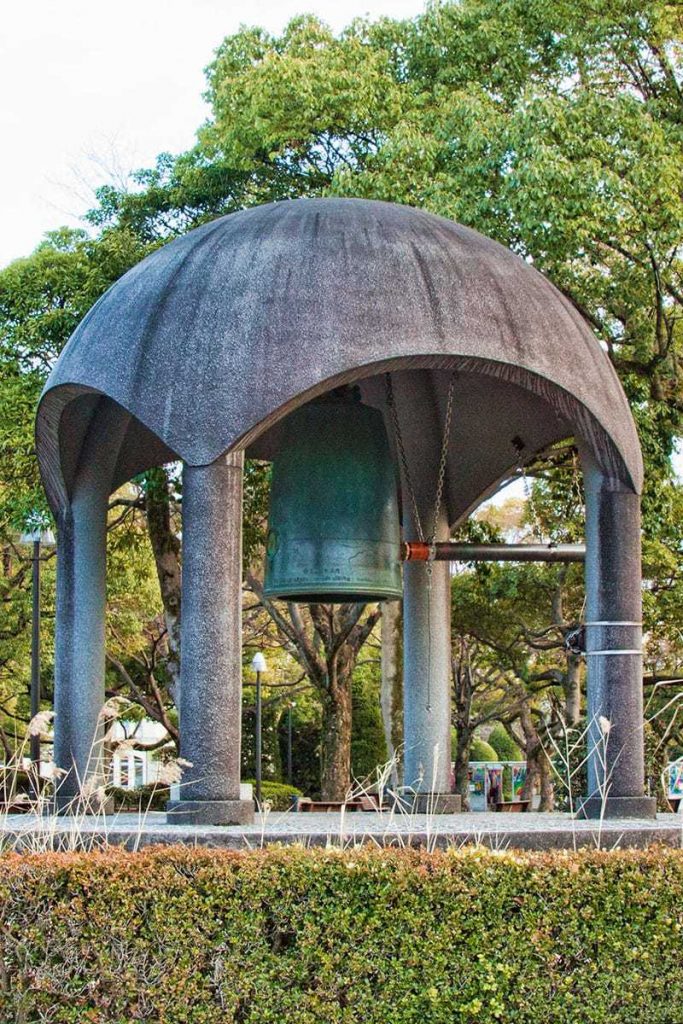
Children's Peace Monument
Sadako Sasaki was only two years old in August 1945 when the first nuclear bomb was dropped on Hiroshima. As a result of her exposure, she contracted leukemia and died 10 years later. Through the commitment of her grieving classmates and with support from over 3,000 other schools in Japan and around the world this monument was built in 1958 to mourn all the children who died from the atomic bomb.
At the base, it reads
This is our cry. This is our prayer. For building peace in this world
At the top of the three-legged pedestal is the bronze figure of a girl holding a gold origami crane high over her head. Surrounding it are glass cases displaying thousands of paper cranes made and sent from schools all around the world.
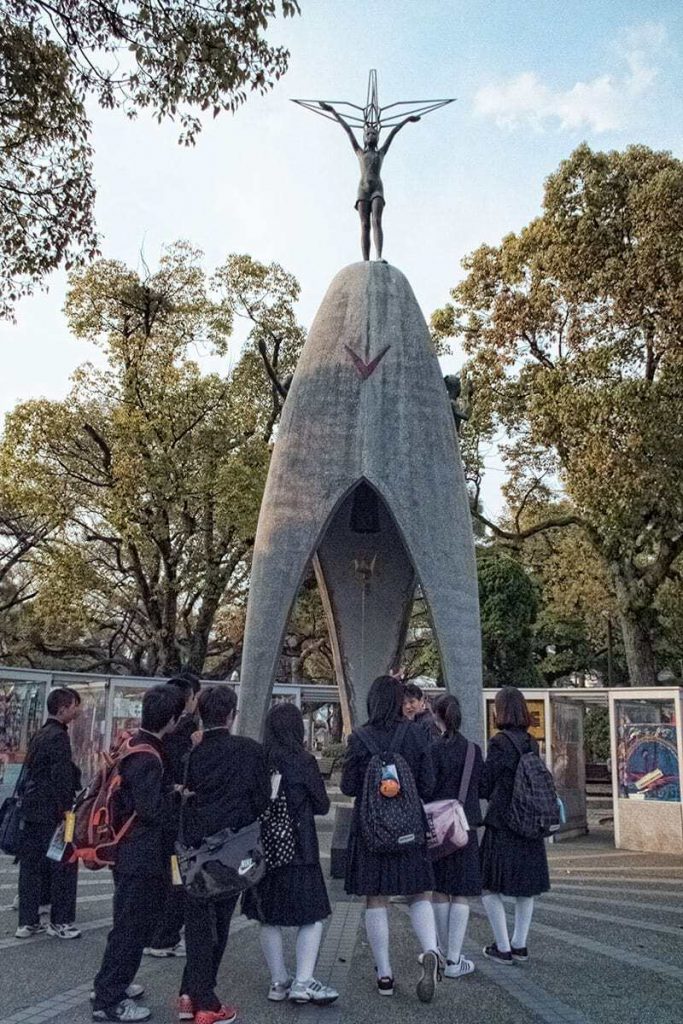
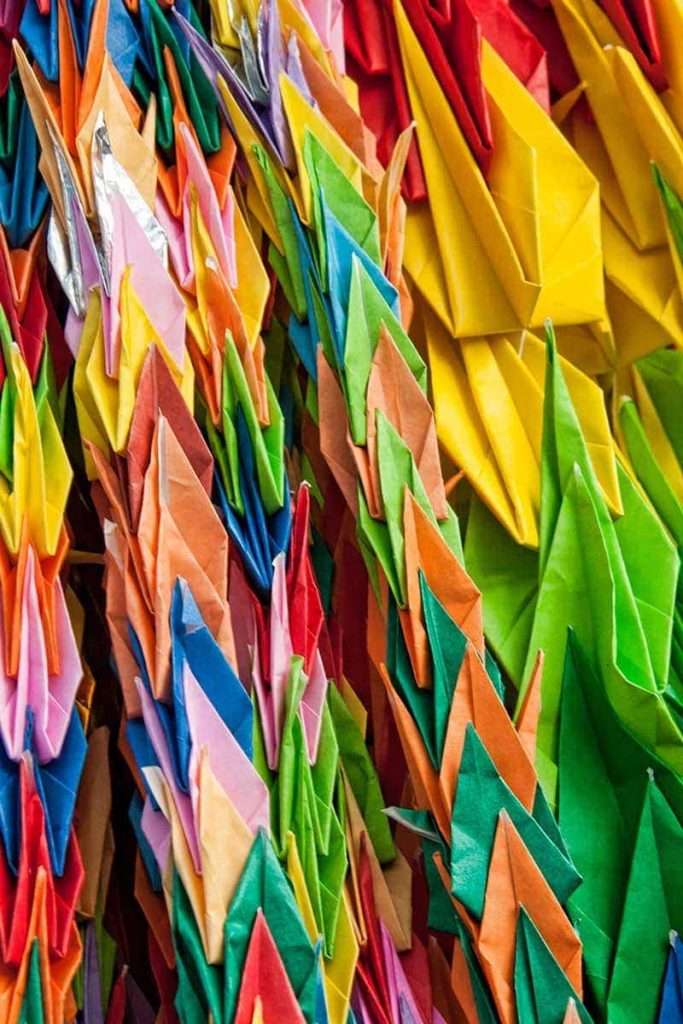
The child represented on the monument is generally thought to be Sadako-san, do you know her brave story and how an origami crane came to be a symbol of world peace?
Sadako Sasaki's story
Sadako seemed to recover well from her initial injuries and it wasn't until she was 11 that she displayed the symptoms of Leukemia, a condition so prevalent among Hiroshima bombing victims that it came to be known as the atom bomb disease.
While she was in the hospital she was shown colourful paper cranes and told the old Japanese legend that anyone who folded 1,000 cranes would be granted a wish.
Sadako had folded 644 cranes before she passed away the following year, her classmates made up the remaining 356 to be buried with her. Sadako wished for world peace and in her way, through her story, she made a substantial contribution in bringing together children of her own and future generations from many countries and nationalities.
Flame of Peace
The flame of peace has a significant symbolism in Japan as well as many Western countries where an eternal flame burns at many cenotaphs. The source of the flame in the Peace Park is from the Kiezu-no-Reikado temple hall high on Mt Misen where it's been burning for 1200 years since the time of Kobo Daishi.
You can read more about its origin in this post about Mt Misen on the beautiful Miyajima Island. If you have time while staying in Hiroshima you might add Miyajima Island to your itinerary. It's both a beautiful and interesting place to visit.
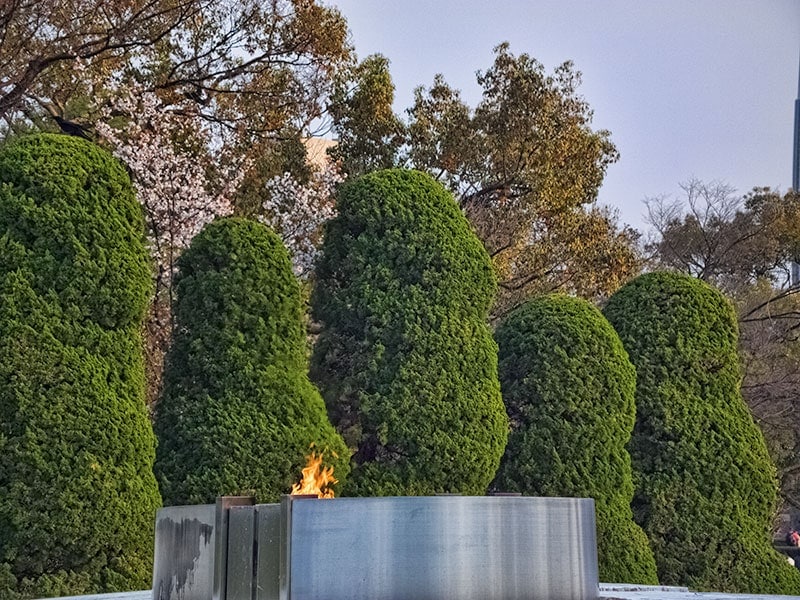
The Memorial Cenotaph
The Cenotaph is constructed in an arch shape towards the middle of the park between the A-bomb dome and the Peace Memorial Museum.
A cenotaph is a monument that recognises and honours those whose remains are in another location, in this case, the shape is representative of a shelter or protection for those who died. In traditional Shinto style, a vault lies underneath containing a list of the names of those who died.
The epitaph is written in formal Japanese and has caused some division and controversy over the years. Several times right-wing Japanese citizens have defaced the cenotaph in protest.
The debate is over the use of an ambiguous pronoun that can mean either 'we' or 'they' in this context. Today, reading the words engraved most would understand 'we' to be an inclusive pronoun, hoping that all citizens and leaders of the world have learned from the errors of the war on all sides. That was certainly the intention of Japan's government of the time, they even erected an additional sign explaining it.
Please rest in peace, for we (they) shall not repeat the error
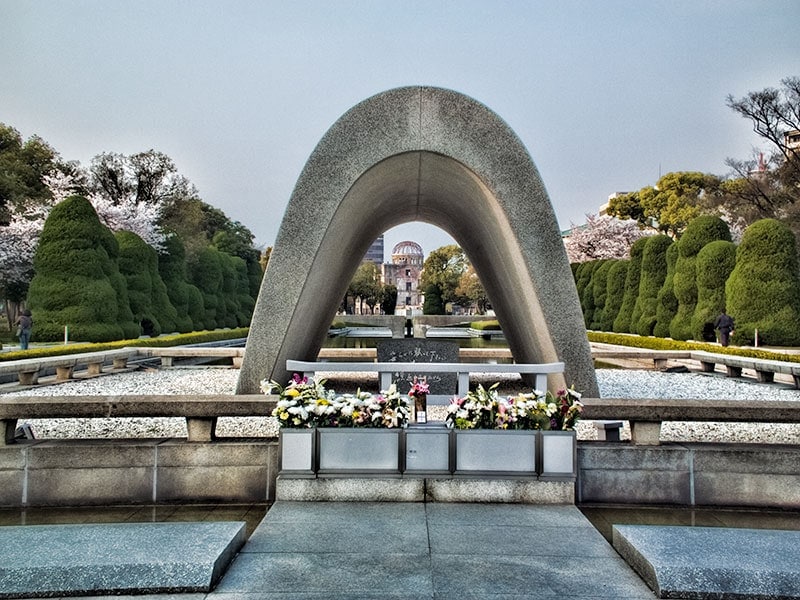
Hiroshima Peace Memorial Museum
I found the museum quite emotional to visit. It houses a substantial collection of exhibits with sufficient narrative in English for a solid understanding of the history. The presentation of the museum is factual and neutral in language, seeking to educate on the physical, social and personal cost of the atomic bomb rather than place blame and question the actions of individuals and governments of the time.
Outside the entrance is a clock that counts down from when the last atomic bomb was detonated in the world and inside are large boards documenting each subsequent detonation which is a disturbing number. Far more countries were involved and explosions far more frequent than I had any idea had taken place.
The sculpture in the foreground of the photo below is by the late Sapporo artist Shin Hongo. Titled Mother and child in the Storm it depicts a mother's grief while enduring suffering and loss.
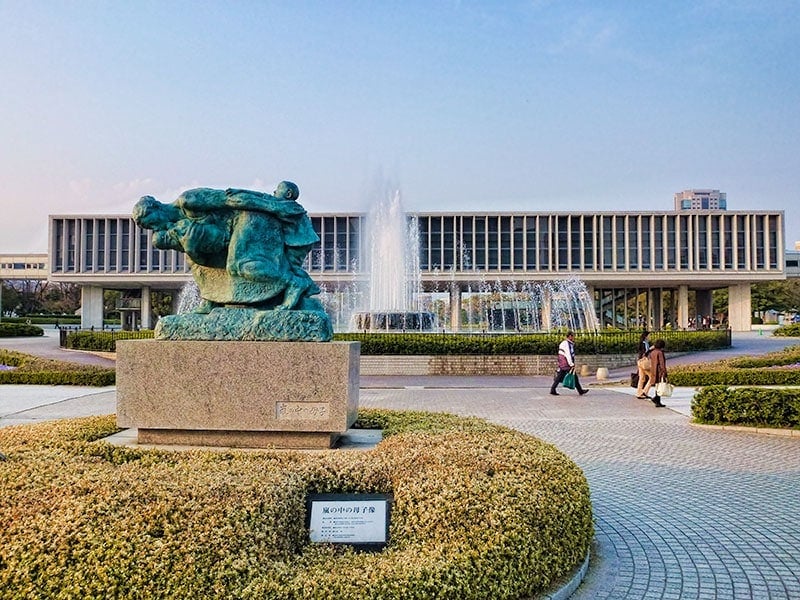
Memorial for the mobilised students
In August 1941 students and teachers were formally organised in the style of military units to assist in the war efforts. In 1944 it was expanded to a year-round initiative.
Students of elementary school age were put to work, schools were turned into military factories and students were required to make munitions, aeroplane parts and sew uniforms. There were around 8,400 children in enforced military labour in Hiroshima alone, and 6,907 of them died when the atomic bomb dropped.
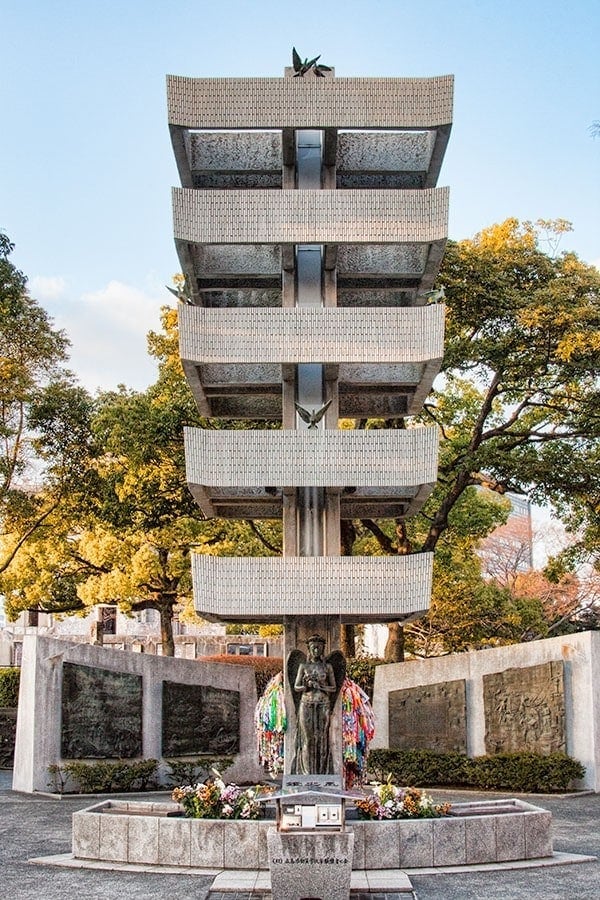
Seasonal events at the Hiroshima Peace Park
April
As the sakura buds burst along the river banks the Peace Park hosts families, friends and work parties celebrating with Hanami parties. The ubiquitous blue tarpaulins are in evidence as they are everywhere at this time of year staking out a space for private gatherings but if you pick up a bento or treats from the bakery you'll surely find a pretty spot to sit and enjoy them with the faint smell of blossom and the river as a backdrop.
August
On the morning of 6th August, a service is held in front of the cenotaph, at 8.15 am a minute's silence is observed to honour the victims. In the evening in an ongoing vigil for world peace lanterns are floated in the Motoyasu River next to the park.
November / December
Along Peace Boulevard and spilling out into the city centre, Dreamination is a light-up event that runs from 5.30 until 10.30 pm each night. Trees are lit up along with large-scale sculpture pieces in a fairyland theme.
Getting to the Hiroshima Peace Park
Making your way from Hiroshima station to the Peace Park will generally either be on foot or via the city's tram network which leaves directly in front of the station. Take tram 2 or 6 and you will be at Ganbaku Domu Mae stop in around 15 minutes.
If you choose to walk, the direct route is under 3km and will take about 40 minutes, you can pick up a free English walking map inside the station. Taxis are also available but are a more expensive option.
An interesting walking route or self-guided tour of Hiroshima can be taken incorporating the Shukkeien Gardens, Hiroshima Castle, and the Peace Park and returning via the shopping district and restaurants or on the tram.
Useful Information when visiting Hiroshima
Hiroshima Self Guided Walking Tour
Our top way to experience Hiroshima is on foot so we've put together this self-guided walk including a map and all the information you'll need along the way so you don't miss anything. We've also covered some short cuts and where you can use the efficient public transport system to reduce the distance a little if you prefer.
A Visitors Guide to Miyajima Island
Miyajima Island is one of the most picturesque places in Japan and that is a huge accolade given the incredible scenery and culture the country has to offer. What many people don't realise is that there is far more to this island than just the floating gate and shrine.
The Japan Rail Pass | Everything you need to know
Most international flights leave through Tokyo and Osaka which can make a Japan Rail Pass a useful purchase when Hiroshima is part of your Japan itinerary. It's not a certainty though so be sure to read this one to find out everything you need to know about the JR Pass including when you DON"T need it!
We've visited the Peace Park on two separate visits to Japan and I find it a hugely emotional but positive experience. Please share your experiences of the Hiroshima Memorial Peace Park or other memorials around the world in the comments below.

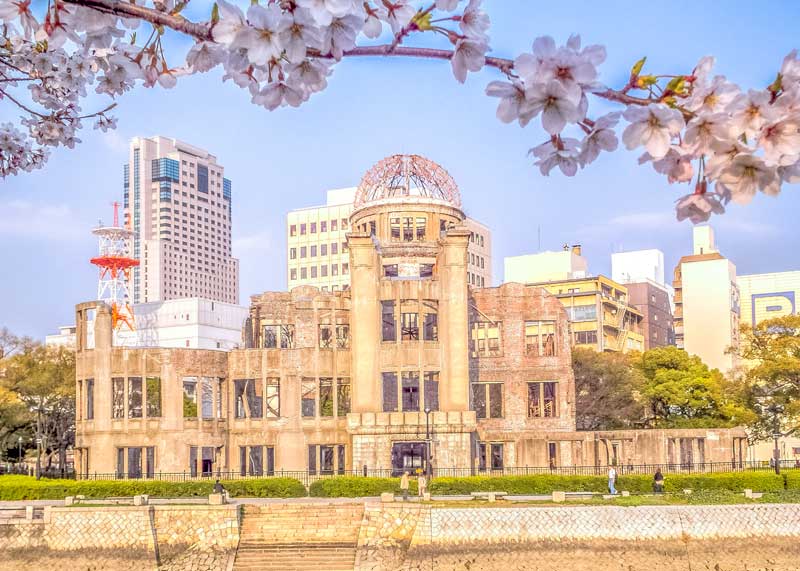


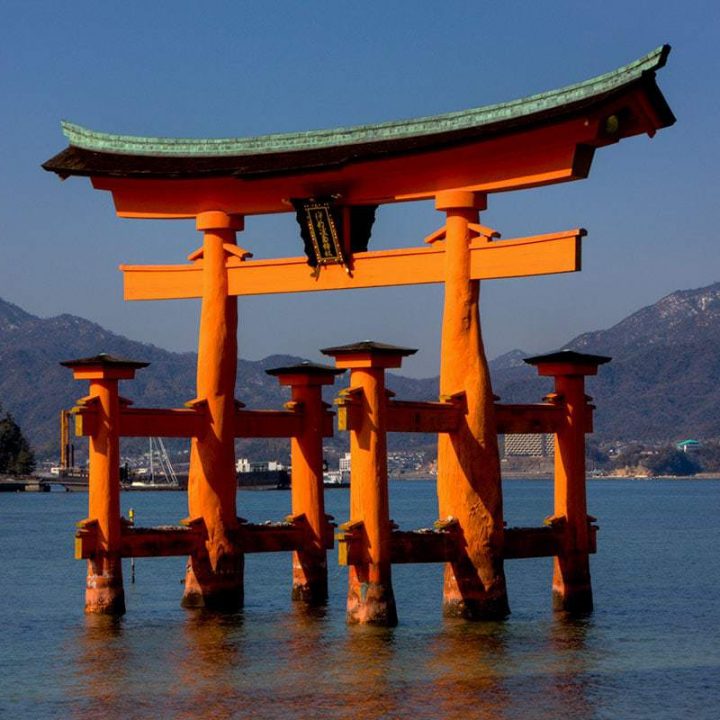
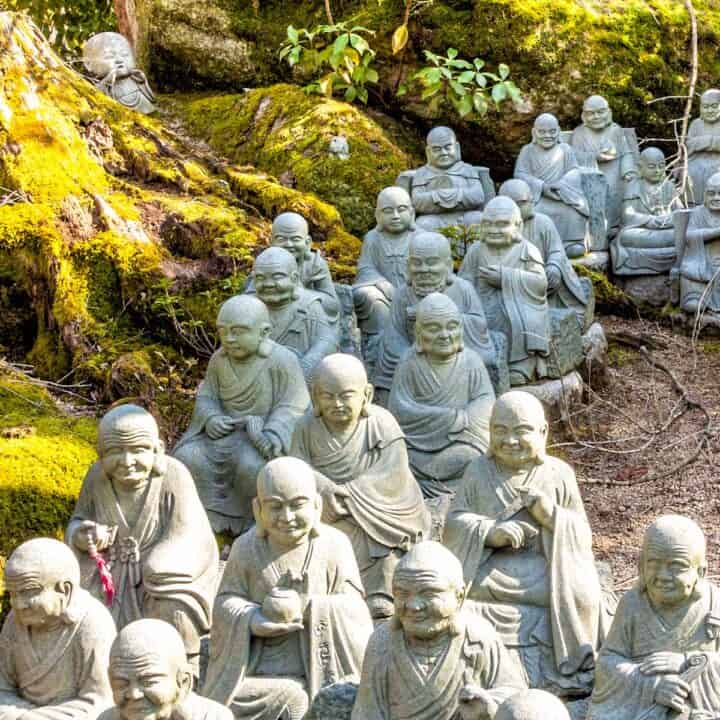
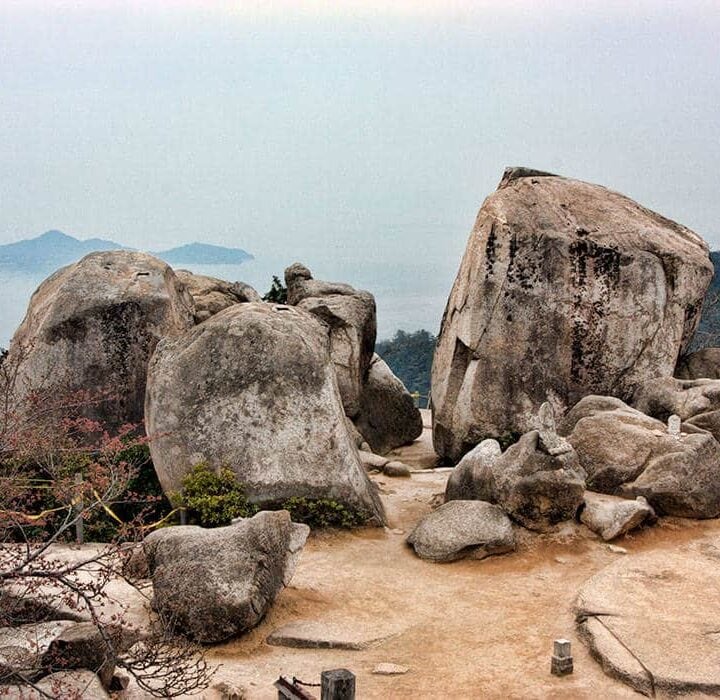
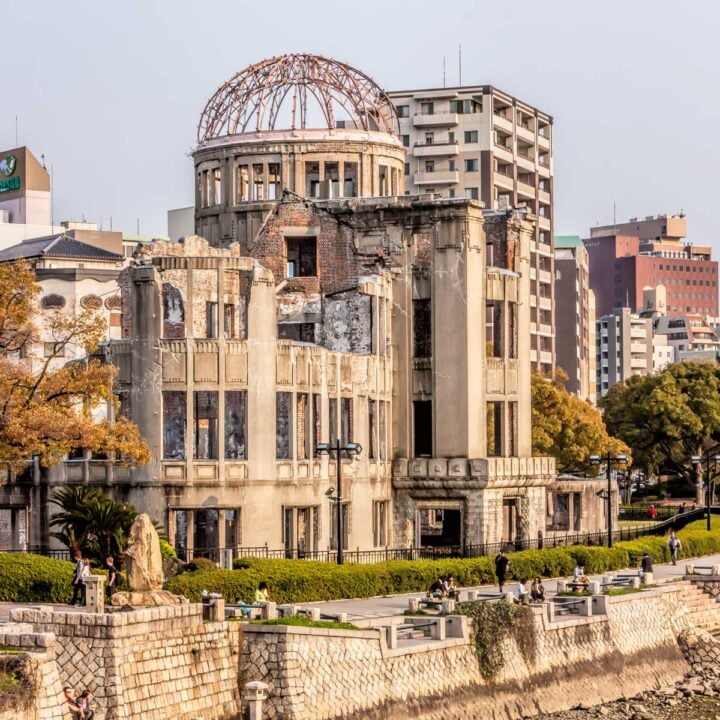
Sally says
Very informative post, I am going to print this off and take it with me for my trip. I chose to self guide rather than paying for a tour, this post will make that so much easier.
2 Aussie Travellers says
Thanks Sally, it's an emotional place but the message is positive and I think a great opportunity for children to learn why peace and everyone learning to live together matters so much.
Kate @adventuremumma says
Went there years ago when i was living & teaching in Japan (pre-kids) & still resonates even today. The paper cranes was something thats still very vivid in my memory & very inspired by the story behind it. Good info on the area.
Michela of Rocky Travel Blog says
Very informative and moving article! I have bookmarked this page for a trip to Japan!
2 Aussie Travellers says
Thanks Michela, enjoy your trip!
Duke Stewart says
It's been wonderful to walk through a truly memorable place, Toni. This is the place where I made lots of changes in my worldview and honestly, I think it's a place everyone should visit. Thanks for reminding me about the Peace Park, Toni. Take care.
Sonal of Drifter Planet says
The flowers look really beautiful. I want to visit this place but I know I will shed a few tears if I do.. Places such as these make you question and appreciate the value of life.
Joe says
Great post! I was just here too! It's an amazing place! I love the pictures!
anneklien says
What a beautiful place to commomerate a very sad and tragic part of our history.
Claudia says
This is high on my list of places to visit when we tour Japan in 2017. I really hope that we can visit during Sakura festival time.
2 Aussie Travellers says
The cherry blossoms are definitely a great time to visit, we've managed to time it perfectly on two trips but there is a bit of luck involved as the dates move around a bit. Have a fabulous trip and let me know if you have any questions we might be able to help with.
Brianna says
I'm sure a visit here is a very sobering experience. Hopefully we don't have a repeat of these tragic events.
melody pittman says
What a sombering post! I cannot imagine visiting this amazing place without being full of emotion and sadness the entire time. Loved the Flame of Peace and that huge tower dedicated to the students. They have done a great job of preserving and memorializing these grounds.
Hugo says
I'm thinking of potentially visiting Japan next year and Hiroshima is one of the places I want to go.
It's such an important place and this peace park highlights exactly that.
Good read!
2 Aussie Travellers says
We've been a number of times and are planning our next trip, it's a fun and fascinating place to visit. If you do get there have a wonderful time and I look forward to reading all about it.
Jackie | The Globetrotting Teacher says
What an informative and moving post! I love how the peace clock chimes every day at 8:15. It's such a poignant way to show, we not only remember, but also teach and live the message of peace. I have seen the children's book titled Sadako and the Paper Cranes but have not read it. It's seen as historical fiction, so it would be interesting to learn the differences between it and the actual history. Thanks so much for such an inspiring post.
2 Aussie Travellers says
HI Jackie, I hadn't realised it was a childrens book, I guess the story would have been softened somewhat as it is quite tragic. I'll try to find it as I'd be interested to take a look.
Traveling Rockhopper says
It's a very special place... I was there in December, but the weather was lovely.
Did you also go to Hiroshima Castle?
2 Aussie Travellers says
We've been in both winter and spring Maja. We visited the Castle during the cherry blossoms and were lucky to catch it close to peak so spent some time sitting under the trees around the moat, it was really beautiful. I know it's not an original castle but it was still quite striking and it's place in history very interesting all the same. Did you enjoy the castle?
budget jan says
Your Hiroshima A Guide to the Peace Park photograph is incredibly beautiful and a fitting photo for such an emotion inducing post. I'm off to visit your Self Guided Walking Tour now. I did know the poignant story of the 1000 Paper Cranes.
2 Aussie Travellers says
Thanks Jan, those little paper cranes are fiddly to fold but it's pretty cool that schools all around the world teach kids to fold them as part of learning about history and the message of peace.